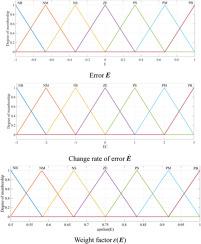Sensors and Actuators A: Physical ( IF 4.1 ) Pub Date : 2021-09-04 , DOI: 10.1016/j.sna.2021.113062 Liang Tang , Yanfeng Fan , Fangping Ye , Wenzheng Lu

|
The application fields put forward higher requirements for the core technology of inertial measurement unit, namely orientation estimation. Generally, estimation of inertial measurement unit orientation is carried out by the fusion of different sensors including geomagnetic sensor and motion sensor, but in some specific environments, the field of magnetic is chaotic and inertial measurement unit itself has the interference of acceleration, orientation estimation algorithm for inertial measurement unit is required to have higher accuracy and stronger robustness. In this work a new approach is presented for estimation of inertial measurement unit orientation. The approach is based on inertial measurement unit containing gyroscope, accelerometer and magnetometer, and a fusion algorithm using Nesterov’s accelerated gradient improved by fuzzy control rule is conducted to estimate inertial measurement unit orientation. Magnetometer is used for measuring the yaw angle, whereas gyroscope, accelerometer provide information for roll and pitch angles. The experimental platform is constructed using motion sensor MPU6050 and magnetometer IST8310, the accuracy and robustness of this approach using Nesterov’s accelerated gradient improved by fuzzy control rule are vertified by four groups of comparative experiments. Experimental results indicate that compared with complementary filter and gradient descent, this approach shows an improvement in estimation of inertial measurement unit orientation.
中文翻译:

使用模糊控制规则改进的 Nesterov 加速梯度估计 IMU 方向
应用领域对惯性测量单元的核心技术,即方位估计提出了更高的要求。通常,惯性测量单元方向的估计是通过地磁传感器和运动传感器等不同传感器的融合来进行的,但在某些特定环境中,磁场是混乱的,惯性测量单元本身存在加速度、方向估计算法的干扰惯性测量单元要求更高的精度和更强的鲁棒性。在这项工作中,提出了一种估计惯性测量单元方向的新方法。该方法基于包含陀螺仪、加速度计和磁力计的惯性测量单元,并采用模糊控制规则改进的Nesterov加速梯度融合算法进行惯性测量单元方向估计。磁力计用于测量偏航角,而陀螺仪、加速度计提供滚转角和俯仰角的信息。实验平台采用运动传感器MPU6050和磁力计IST8310搭建,通过四组对比实验验证了该方法利用模糊控制规则改进的Nesterov加速梯度方法的准确性和鲁棒性。实验结果表明,与互补滤波器和梯度下降法相比,该方法在惯性测量单元方向的估计上有所改进。而陀螺仪、加速度计则提供滚转角和俯仰角的信息。实验平台采用运动传感器MPU6050和磁力计IST8310搭建,通过四组对比实验验证了该方法利用模糊控制规则改进的Nesterov加速梯度方法的准确性和鲁棒性。实验结果表明,与互补滤波器和梯度下降法相比,该方法在惯性测量单元方向的估计上有所改进。而陀螺仪、加速度计则提供滚转角和俯仰角的信息。实验平台采用运动传感器MPU6050和磁力计IST8310搭建,通过四组对比实验验证了该方法利用模糊控制规则改进的Nesterov加速梯度方法的准确性和鲁棒性。实验结果表明,与互补滤波器和梯度下降法相比,该方法在惯性测量单元方向的估计上有所改进。通过四组对比实验验证了该方法利用模糊控制规则改进的Nesterov加速梯度方法的准确性和鲁棒性。实验结果表明,与互补滤波器和梯度下降法相比,该方法在惯性测量单元方向的估计上有所改进。通过四组对比实验验证了该方法利用模糊控制规则改进的Nesterov加速梯度方法的准确性和鲁棒性。实验结果表明,与互补滤波器和梯度下降法相比,该方法在惯性测量单元方向的估计上有所改进。











































 京公网安备 11010802027423号
京公网安备 11010802027423号